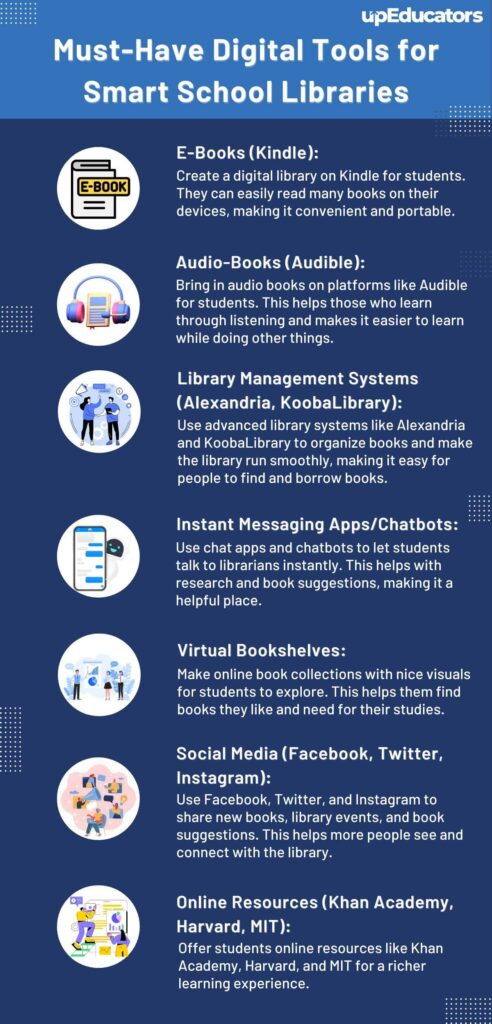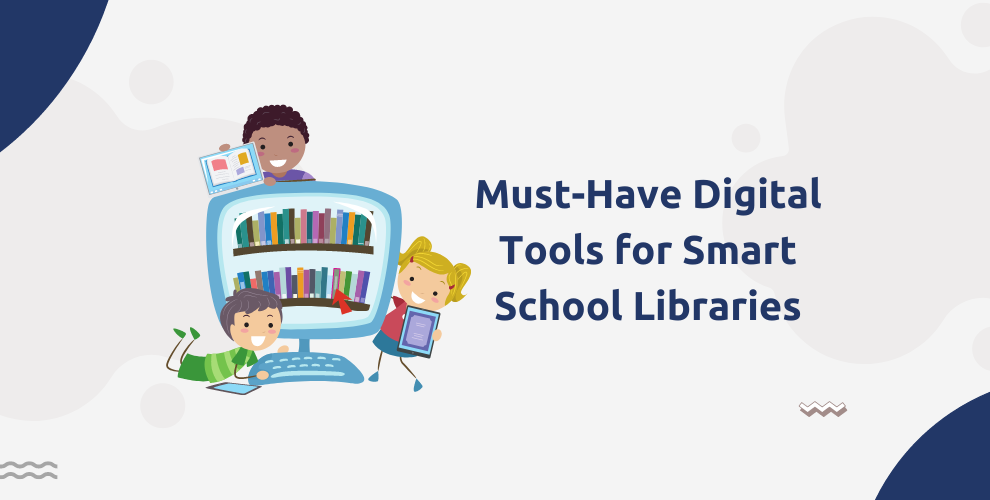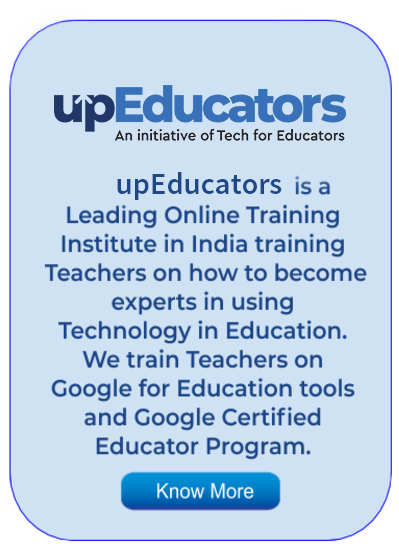If a school is a body, then the library is the heart that pumps blood in the form of books and resources. Libraries hold significance in an educational space and provide a breeding ground for research and education. But are traditional libraries lagging?
For example, a smart school in Mumbai boasts a collection of thousands of books in its library. But despite thousands of books, students are found glued to smart boards and screens used in all other departments of the school and enjoy learning through smart devices. So it is the time when libraries also need to become smart?

Many librarians shrug off approaching technology and think that technology is not meant for libraries. But this is untrue. Technology is here to make our jobs easier. If librarians open their arms to technology, their work can become easier.
upEducators has trained thousands of teachers in using digital tools and technology in the classroom. Our team of expert trainers have a detailed understanding of the benefits these tools can bring to learning. And our trainers have created a list of tools and tips that can help schools in building smart libraries. So let’s look at this list and get started to transform our libraries into smart libraries.
Use E-Books (Kindle)
One major benefit is that e-books take up significantly less physical space than traditional books. This means that you can store a much larger collection of books in the same amount of space, and you won’t have to worry about running out of room for your library to grow. Additionally, e-books are often cheaper than physical books, so you can save money while building your library. Many e-books can be found free of charge also. Another advantage is that e-books are portable and easily accessible. Additionally, E-books and Kindle readers have built-in text-to-speech features, which allow the visually challenged to easily access and read books.
Use Audio-Books (Audible)
Audiobook apps like Audible help in building smart libraries by providing access to a wide range of books in audio format, making it easy to purchase and download books, offering features to enhance the listening experience, and providing a library feature to keep track of books. It also enables listening on multiple devices and allows for multitasking. They make books more accessible and convenient for users.
Library Management Systems (Alexandria, KoobaLibrary)
Library management systems like Alexandria and KoobaLibrary are crucial tools for building a smart library. These systems provide a variety of functionalities that help librarians and library staff manage, organize, and make their collections available to patrons.
One of the most important functionalities of a library management system is cataloguing, which enables librarians to record and store bibliographic information about books, including title, author, publisher, and subject matter.
Another key functionality is circulation, which allows library staff to keep track of which books have been checked out, by whom, and when they are due to be returned. Library management systems also provide functionalities like acquisitions and serial control.
Moreover, Reporting and Analytics provide data and insights into how library resources are used.
Self-service portals and mobile access allow patrons to access the library’s catalogue and resources online, place holds, and request and renew items.
Instant Messaging apps/Chatbots (to connect with librarians instantly)
Instant messaging bots and portals can help libraries become smart by providing a convenient and easy-to-use way for students to connect with libraries. These bots and portals can perform a variety of tasks. Libraries can integrate Library Chatbots like MyLibrary and BiblioCommons to make the experience more interactive and simple.
The bot can answer students’ questions about library hours, locations, and services. It can also provide information about the library’s catalogue, including what books are available and where they can be found.
Furthermore, the bot can also allow students to check out and renew books using their mobile devices, eliminating the need for a physical trip to the library. The instant messaging bot can also allow students to place holds on books and request specific titles from the library, which will reduce the wait time for students.
Furthermore, the bot can also send students notifications of new arrivals in the library’s collection.
Virtual Bookshelves
Virtual bookshelves apps play a vital role in promoting reading among students and building smart libraries. Such apps allow students to keep track of the books they have read, create reading lists, and set reading goals. This can help students stay organized, and motivated, and reflect on their reading progress.
Moreover, they can recommend books to students based on their reading history, preferences and interests. This can help students discover new books and authors that they may not have found on their own, which can increase reading engagement and foster a sense of curiosity. Many virtual bookshelves apps have a social component, which allows users to connect with other readers, share reviews, and discuss books they’ve read. This can be a great way to get students excited about reading.
Social Media (For new arrival updates- Facebook, Twitter, Instagram)
Social media platforms like Instagram and Twitter can be used to promote a library’s resources and services to a wider audience, as well as to engage with patrons and gather feedback on the library’s offerings. Additionally, the library can use these platforms to share news and updates and to create and curate content that is relevant to the community it serves. They also can help to build a sense of community and engagement with students, which can lead to an increased usage of the library’s resources and services.
Use online resources (Khan Academy, resources from Harvard, MIT)
Online resources such as academic papers and educational content can be useful in building a smart library. These resources can supplement the physical resources and services offered by the library, making it a more comprehensive and diverse learning and research centre.
For example, by providing access to academic papers from reputable institutions such as Harvard University, a library can offer patrons access to cutting-edge research in a variety of fields. Similarly, educational content from organizations like Khan Academy can be used to support students who are looking to learn new skills or brush up on existing ones.
Additionally, many of these resources can be accessed remotely, which allows patrons to access the library’s resources and services from anywhere, at any time. This can be especially beneficial for students who may not be able to visit the library in person.
Overall, online resources can be a valuable addition to a library, as they can help to make the library more versatile and responsive to the needs of its patrons.
Building a smart library requires a variety of digital tools to support learners and enhance their experience. Social media platforms like Instagram and Twitter can be used to promote resources and services, gather feedback, and create a sense of community.
Online resources such as academic papers from reputable institutions and educational content from organizations like Khan Academy can supplement the physical resources and services offered by the library. Digital catalogues and online databases can help students discover the library’s collection and access resources from anywhere. E-book and audiobook platforms can give patrons access to a wider range of reading materials. With the use of these tools, libraries can provide an inclusive, diverse and versatile resource center that meets the ever-evolving needs of the community it serves.
Author: This article is written by Samiya Rashid for upEducators blog.




